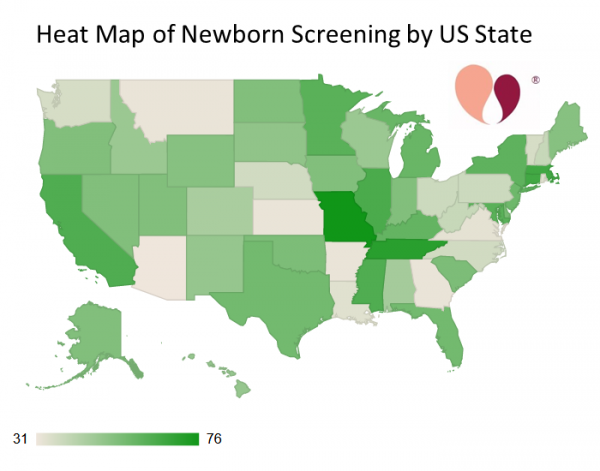You are here
Newborn Screening Complements Cord Blood Banking
September is National Newborn Screening Awareness Month, a time to help raise awareness of newborn screening among parents, healthcare professionals, and the public. Newborn screening has been one of the biggest public health successes since it was first introduced in the 1960s1-3. Its goal is to identify children who may be at risk for severe but treatable conditions, and get them the care they need as soon as possible.
Over the past 55 years, newborn screening has been credited with saving or improving the lives of thousands of children with serious but treatable disorders, such as phenylketonuria, sickle cell anemia, and cystic fibrosis. Newborn screening is not just a matter of testing for conditions… “rather, it is a complex, integrated system that begins with timely testing, scrupulous follow up of patients, tracking of outcomes, quality improvement of all aspects of the process, and education of providers, staff, and parents.”3
In 2008, the United States Congress passed the “Newborn Screening Saves Lives Act”, which established guidelines for newborn screening4,5. As part of this law, the Recommended Uniform Screening Panel, or RUSP, was created6. The RUSP is a list of 35 conditions that are approved by the Department of Health and Human Services as a minimum newborn screening panel. However, the RUSP is not mandated, it is only a guideline for states when developing their own newborn screening programs.
One of the major health issues facing new parents in the US, whether or not they are aware of it, is that newborn screening varies dramatically from state to state. Depending on where you live when your child is born, your baby will receive a different screening panel. The website, Baby’s First Test, maintains a database that enables parents to look up the newborn screening panels on a state by state basis1. Based on their data, accessed 1 June 2020, Parent’s Guide to Cord Blood created a heat map to display the number of newborn screening tests in each state. The number of tests in the state panel ranges from a low of 31 in Arizona to a high of 76 in Missouri. There are 8 states that fall below the 35 tests recommended in the RUSP.
Expansion of newborn screening programs used to be driven by new testing technology, but now is increasingly driven by the development of novel therapeutics and political advocacy3. In order to add more medical conditions to state newborn screening panels, families and advocacy groups must lobby state legislatures. The process of advocating for a bill to become a law can take more than one legislative session and requires communication with key lawmakers, expert testimony, and perseverance. It may take years to add one condition to one state newborn screening panel.
A case in point, the charity Hunter’s Hope is fighting to add a test for Krabbe Leukodystrophy to newborn screening panels7. Hunter (2/14/97—8/5/05) was the son of Jim Kelly, Pro Football Hall of Fame Member and former Buffalo Bills Quarterback, and his wife Jill. Dr. Joanne Kurtzberg of Duke University has argued in support of Krabbe screening, because her research team has shown that Krabbe can be cured by a cord blood transplant if it is administered during the first month of life8,9. The first state to begin screening for Krabbe was New York in 2006, and other states have followed, but progress has been slow due to debates about the accuracy of the screening and the risks of cord blood transplantation10.
Parents that want to be proactive and make sure that their new baby is screened for all actionable genetic conditions can purchase supplemental newborn screening. This testing can be done either when their child is still in the hospital or shortly after they come home. With current genetic testing technology, it is possible to go beyond the RUSP and screen for hundreds of conditions that are considered severe but treatable11. Unlike state-mandated newborn screening that is covered by health insurance, parents must pay out of pocket for supplemental newborn screening tests.
Some family cord blood banks are partnering with genetic testing companies to offer expanded newborn screening to their client families. There is a natural synergy between cord blood banking and newborn screening, both of which are intended to protect the baby’s health, and both of which should be performed at the time of birth.
Parent’s Guide to Cord Blood Foundation finds that only two or three family cord blood banks in the United States offer newborn screening. In other countries that do not have any automatic newborn screening, many banks are offering newborn screening. The existence of required newborn screening in the United States gives many parents and medical professionals the sense that this base has been covered. That sparks debates over whether this is a false sense of security, and whether states should be taking full advantage of the tests that are possible with current technology3,11.
As expanded newborn screening becomes more visible, we expect that more parents will take advantage of this opportunity. Those families that detect an actionable medical condition will be empowered to get medical care sooner and make health decisions that improve life for both their child and their family. If you are interested in this option, ask your potential cord blood bank about availability.
References and Resources
- 1. Baby’s First Test. Conditions Screened by State. web page Accessed 2020-06-01
- 2. March of Dimes. Newborn Screening Tests for your Baby. web page Accessed 2020-06-01
- 3. McCandless SE, Wright EJ. Mandatory Newborn Screening in the United States: History, Current Status and Existential Challenge. Birth Defects Research. 2020; 112(4):350-366.
- 4. GovTrack. Newborn Screening Saves Lives Act of 2007. (S.1858) Legislation Accessed 2020-06-01
- 5. United States Senate. Newborn Screening Saves Lives Reauthorization Act of 2019. (S.2158) Legislation Accessed 2020-06-01
- 6. Health Resources and Services Administration. Recommended Uniform Screening Panel. web page. Last updated 2018-07
- 7. Hunter’s Hope. Newborn Screening. web page Accessed 2020-06-01
- 8. Prasad VK, Mendizabal A, Parikh SH, Szabolcs P, Driscoll TA, Page K, Lakshminarayanan S, Allison J, Wood S, Semmel D, Escolar ML, Martin PL, Carter S, Kurtzberg J. Unrelated donor umbilical cord blood transplantation for inherited metabolic disorders in 159 pediatric patients from a single center: influence of cellular composition of the graft on transplantation outcomes. Blood 2008; 112(7):2979-2989
- 9. Kwon JM, Matern D, Kurtzberg J, Wrabetz L, Gelb MH, Wenger DA, Ficicioglu C, Waldman AT, Burton BA, Hopkins PV, Orsini JJ. Consensus Guidelines for Newborn Screening, Diagnosis and Treatment of Infantile Krabbe Disease. Orphanet J Rare Disease 2018; 13(1):30.
- 10. Goodman B, and Miller A. Would You Want Your Baby Tested For This Disease? WebMD 2017-03-09
- 11. Millington DS. The Role of Technology in Newborn Screening. North Carolina Med. J 2019; 80(1):49-53.


